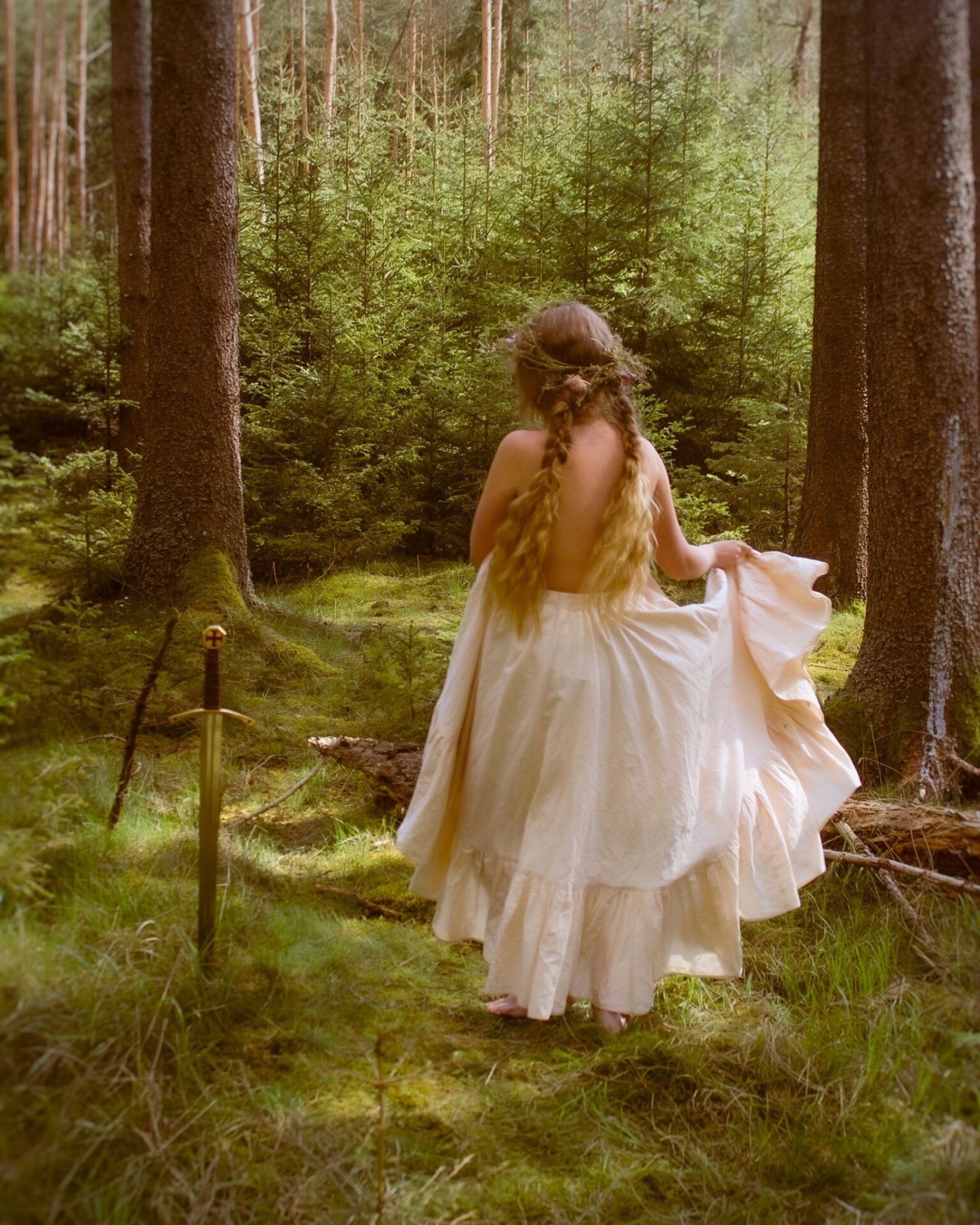Beltane (also known as May Day) is one of the four main festivals, or quarters, on the Wheel of the Year and a very important one at that. Beltane was originally a Celtic celebration of the sun and the fertile land below. During this time, we revel in the warmth of the sunshine as well as the growth, vitality, and fertility that it promises.
This holiday is known to the Irish as Lá Bealtaine, which translates roughly to “bright fire.” As such, it is a significant fire festival thrown in dedication to the gods to ask for their divine blessings of abundance during the warmer half of the year.
I’ve gotten a lot of questions about the pagan holidays recently and realized that while many people know they exist, not as many folks know what to do on these holidays.
I believe that pagan holidays should be celebrated in a way that feels right, yet it’s also important to understand the symbolism and purpose of the holiday from an energetic standpoint.
In this post, I’ll go over every aspect of Beltane and May Day, and hopefully, you’ll have a better idea of the types of rituals you can do once you get to the end!
What Is Beltane?
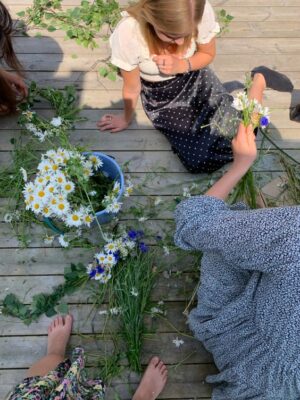
Beltane is a pagan festival that is celebrated at the beginning of Spring, honoring the union of Mother Earth and the Greenman so that we may be blessed with hearty weather and fertile land. While some cultures recognize the Greenman as the Celtic horned god Cernunnos, pagan pantheons are numerous, so this Beltane festival can be celebrated regardless of which fertility deities you choose to work with.
In fact, many different cultures celebrate Beltane in some version. Nowadays, Beltane is often known as May Day.
Beltane is one of the four main fire festivals on the pagan holiday wheel. The other three are Imbolc, Lammas, and Samhain. During these points in time – Beltane and Samhain, particularly – the veil is incredibly thin, and our ability to interact with the spirit realm and ask for the favor of the gods is enhanced.
Traditionally, Beltane was celebrated in Scotland, Ireland, and the Isle of Man in ancient Gaelic times. Falling on May 1st in the Northern hemisphere (or October 1st in the Southern), many cultures choose instead to hold their celebrations on either the last day of April or up through May 5th, depending on the weather and on the days of the week during a particular year.
There are many different Beltane festivals and Beltane traditions that are popular today. However, you can also come up with your own rituals to incorporate Beltane or even May Day into your life. If you’re wondering how to celebrate Beltane, this post should give you a bunch of ideas!
The Meaning Of Beltane:
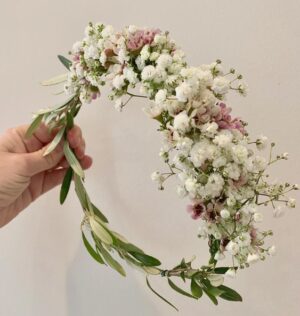
Beltane is about honoring the light half of the year and rejoicing in warmth, passion, fertility, and all of the earth’s blessings. It is a form of veneration of the warm sun, positivity, radiance, and abundance.
During this time of year, spring blossoms are in bloom, the fresh smell of grass fills the air, and all sorts of critters are buzzing about and twitterpated, according to Disney’s Bambi. This is a time of celebrating the fertility of the land as well as the people…erm, sexually, that is. Symbolically, you’ll notice that sex is a big recurring theme.
This doesn’t mean that Beltane rituals are necessarily “inappropriate” in any way. During pagan times, well before Christianity, sexuality was something that was celebrated because it means fertility and abundance. During Beltane, animals give birth, bird eggs hatch, flowers bloom, and sexuality simply enhances reproduction. Beltane is a celebration of life that cannot exist without sexuality.
All that aside, Beltane marks the time that springtime is at its peak. Shepherds begin to lead their livestock out to pasture, and the warmth of the sun – not to mention that added dose of vitamin D – helps to add a little spring to everyone’s step.
It is said that fairies and the fae begin to reawaken at the time of Beltane, too. Referred to as May Day to some cultures, Beltane has a deep association with the May Queen.
The May Queen
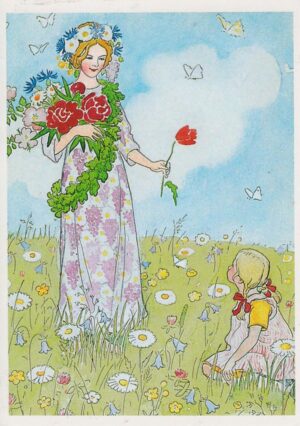
The May Queen was the queen of the fae, known to some as the earth goddess Flora and to others as the maiden and mother aspects of the triple goddess.
Some believe that legends of the May Queen have been used by Christians, as the Veneration of Mary occurs during the month of May and holds many of the same symbols and rituals. However, it’s possible that the energy of this period is potent. This could be why many different religions and cultures venerate the young virgin or mother during May Day.
In modern May Day traditions, a symbolic May Queen is crowned among the young women of the village and adorned with flowers and wreaths.
To many practicing pagans, Beltane tells the story of the May Queen and her unending conflict with the Queen of Winter. As they battle for supremacy, the May Queen triumphs in the Spring and yields at Samhain, allowing the cycle to begin again.
If you practice with the fae, then you may want to consider leaving an offering as part of your May Day traditions. Beltane blessings are extremely important to the fae because they follow the seasonal shifts in nature more closely than we do nowadays.
Beltane Pronunciation
I want to get to all the good stuff, like fun Beltane rituals and traditions to try out, but I first think it’s important to know how to pronounce Beltane.
When I first participated in Beltane, I had no idea how to pronounce it. Nowadays we tend to learn most information from the internet, which means Celtic pronunciation is tough.
The correct pronunciation of Beltane is “Byel-teh-neh.” The first syllable is pronounced like a combination of bell and yell. The second syllable is pronounced like te in ted. The final syllable is pronounced like neh in nest.
How To Celebrate Beltane
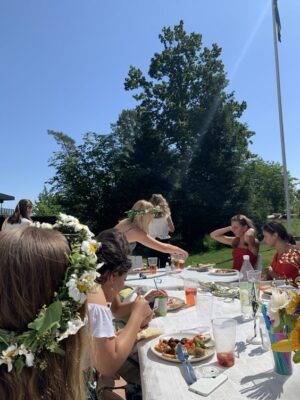
Many pagans celebrate Beltane rituals that embody the warmth of the sun and symbolize the fertility of the land.
Typically, Beltane traditions revolve around these motives:
- Fertility
- Fire
- Passion
- Rebirth
There are many different Beltane traditions from each specific culture. If you practice ancestor work, then you may want to look more into your heritage to find out what Beltane rituals your ancestors might have followed.
Beltane Rituals:
There are many Beltane rituals that can be performed in solitary or as a group practice. Here are some of my favorite Beltane rituals to rejoice in the fertility of Spring.
11. Ritual Bonfire
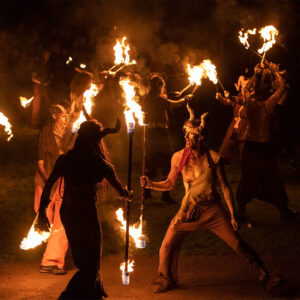
Traditionally, one would take this time to perform rituals of protection over their livestock and crops. This could be done by creating a bonfire whose smoke carried protective energies with it across the land, much like a giant smudge stick.
This is called the “Beltane fire festival” and is one of the most widely-practiced traditions of Beltane to this day. It comes from the ancient Iron Age Celtic yearly ritual.
Because these Beltane ritual bonfires were considered holy, purifying flames, all other nearby flames would be doused to enhance their magical properties, including all hearth-fires and candles on the night of Beltane.
Depending on the location, additional steps would be added to the Beltane fire festival such as parading cattle between two separate bonfires, having them jump through the burning flames, using the ashes as a means of bestowing Beltane blessings from the fire, or carrying home a torch from the fire to relight a family’s hearth.
All were seen as methods of granting the protective and purifying properties of the bonfire upon the practitioners’ families, livestock, and land. Young couples would even jump over or through the smoke of these fires to ask for Beltane blessings of abundant love and fertility.
Beltane fire festivals are still common today. Many pagans like to host a garden or May Day party during the daylight hours and transition to a Beltane fire festival (with more relaxed rules during the night) to really enhance the spirit of the holiday.
10. The Maypole Dance
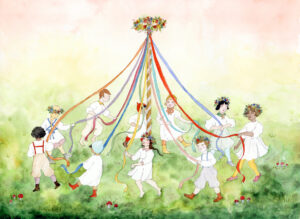
The maypole was considered a phallic symbol, constructed with the intent of penetrating the earth to represent potent Beltane blessings from the god above. At the top of the maypole, a wreath of flowers would be placed to symbolize the fertility of the goddess in classic May Day tradition.
The dance would typically be performed by young men and women, holding different colored ribbons as they circle and interweave with each other around the pole. By the end of the dance, the spun ribbons would create a sheathe encircling the maypole that represented the womb of the earth.
Today, dancing around the maypole with brightly-colored ribbons is often practiced in schools as a fun children’s activity. Though this is a classic May Day ritual that is often done in a secular way, it also functions as a longstanding Beltane pagan tradition.
9. Handfasting Ceremony
As a time of celebrating fertility and abundance, Beltane is a wonderful time for weddings. The handfasting ceremony is one that many choose in place of a traditional wedding, and was once practiced in the British Isles in pre-Christian times.
This bonding ritual has been adopted by many modern-day pagans, Wiccans, witches, atheists, and members of the LGBTQ+ community that may not identify with the idea of a traditional marriage ceremony. This is also a classic Beltane tradition that is really wonderful if you want to go back before Christianity and many popular religions today.
Plus, what’s more enticing than a paga Beltane festival in the form of a wedding? Because the general Beltane meaning speaks to all things new and beginnings, it’s a wonderful energetic period to host a wedding or commitment ceremony.
8. May Bushes
A may bush was a small thorny tree, often a hawthorn or rowan tree, which would be decorated with brightly-colored flowers, ribbons, and decorations. Much like the modern Christmas tree, may bushes would be decorated and placed outside of family homes or in public gathering spaces for all to enjoy.
Bringing home a decorated bush or branch from the may bush would take its Beltane blessings with it. Farmers were known to place the may bush outside of barns to bless their livestock with an abundance of milk for the summer.
This is an easy May Day tradition that is widely practiced across cultures today.
7. Crafting Floral Wreaths & Crowns
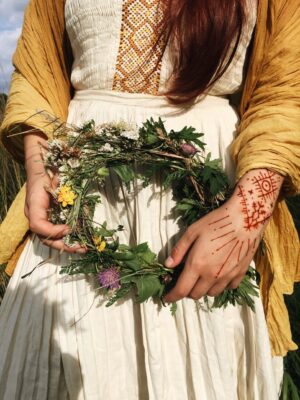
Many choose to celebrate this sabbat by creating something similar on a smaller scale, such as floral wreaths, crowns, and bouquets to decorate homes and doorways. These can be made from the branches of may bushes or other seasonal flowers to bring the Beltane blessings of warmth and fertility into the home.
I personally love this May Day tradition because it’s easy to do and is always a really fun activity!
6. Create A Fairy Garden

Because this is a holiday with deep ties to the fae, we can welcome them and show warmth by creating a fairy garden in your garden or potted plants. Add miniature houses, furniture, trees, and tiny animals and gnomes to make a miniature garden-scape.
If you don’t have your own plants, you can add a little fairy door to a large tree on your property, in a state park, or along a nature trail.
I would advise not inviting the fae into your home or personal space, though. They can be mischievous, so it’s best to always use caution when working with or even approaching the fae.
5. Make Offerings To Fertility Deities
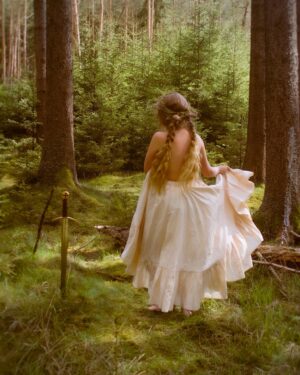
While offerings are often made to Cernunnos or the May Queen, there are many gods and goddesses that one may worship, depending upon their path. Honey, milk, wine, oats, and fruits are common offerings for these entities, but this may vary depending upon your personal practice.
4. Sow Seeds For Your Garden
As a celebration of spring, get your garden started by planting seedlings. You can do this as a solitary practitioner or part of a group. Ask for blessings from your fertility god of choice to ensure a bountiful harvest, or dedicate an entire garden plot in your deity’s honor. While you’re enjoying the fresh air of Spring and the earthy texture of the soil, take the time to ground yourself. Oh, and make sure to water your seedlings, too.
3. Place Yellow Flowers On Your Doorstep

Dandelions, daffodils, primrose, marigolds, and other sunshine-colored blooms can be left on one’s doorstep to welcome blessings of warmth, sunshine, and positivity into the home.
2. Perform Love And Fertility Spells
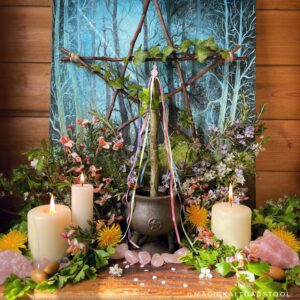
While it is commonly known that the veil is exceptionally thin during Samhain, many tend to forget that the same can be said for Beltane. During this celebration of ripened Earth, it is said that divination, fertility rituals, love spells, and sex magic are especially effective.
1. Cooking With Aphrodisiacs

Kitchen witchery is another great way to use the powers of Beltane to enhance your spellwork! Bake something with aphrodisiacs, like a fig tart or a pie with asparagus and garlic – the possibilities are endless!
Beltane Symbols
Typical Beltane symbols may include the sun, flowers, and anything related to fertility.
However, there are other more specific symbols that you can employ if you want to do a ritual or spell on Beltane. Here are some of the most common Beltane symbols.
Colors: yellow, red, green, white, silver, blue, pink
Crystals: rose quartz, carnelian, garnet, beryl, emerald, malachite, amber
Herbs: yarrow, mint, mugwort
Trees & Fruits: hawthorn, rowan, cherries, pomegranates, peaches
Altar Decorations: antlers, phallic or yoni symbols or statuettes, acorns and seeds, floral wreaths, chalices, swords, candles, ribbons, small maypoles
Associations: yoni & phallus symbolism (fertility), purification through fire, fairies
Yellow flowers were another significant symbol of Beltane, and you’ll see that many of the rituals and traditions listed above would often incorporate rowan, primrose, hawthorn, and other flowers and trees with yellow blooms to represent radiance, joy, and positivity.
While these are the most common Beltane symbols, you can virtually use anything that reminds you of spring, of life, of fire, and of renewal. Beltane is literally a celebration of mother earth renewing herself! Think about Beltane’s meaning and use whatever tools or ingredients feel right for you.
More History Of Beltane:
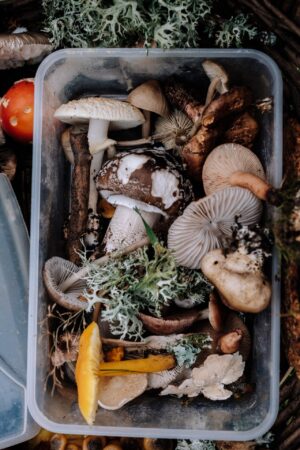
Although Beltane originated within Gaelic countries, similar festivals can be dated back to that of Floralia, celebrated during the time of the Roman Republic. Much like Beltane, this holiday falls at the end of April or the beginning of May, and honors both a god and goddess – Aphrodite and Dionysus, to be exact.
While the decorating of trees and other common Beltane rituals may seem similar to those practiced at Christmastime, it seems this is one holiday that some Anglo-Saxon Christians deemed a little too pagan to appropriate.
This comes as no surprise, seeing as many Beltane celebrations honor both a god and goddess, not to mention the sexual themes surrounding the union of the two.
Roman Catholics, however, observe May Day as a feast day for the Blessed Virgin Mary. Statues of Mary are adorned with floral crowns during this time, and works of art are often made and dedicated to the Virgin Mary throughout the month of May.
I hope this gives you ideas for Beltane traditions, rituals, and ways to celebrate this wonderful Sabbat! Beltane’s meaning is multi-layered but is always accessible to us everyday people.
After all, it’s really just a celebration of the seasons here on earth. If nothing else, use this time to reconnect with nature and renew yourself.

